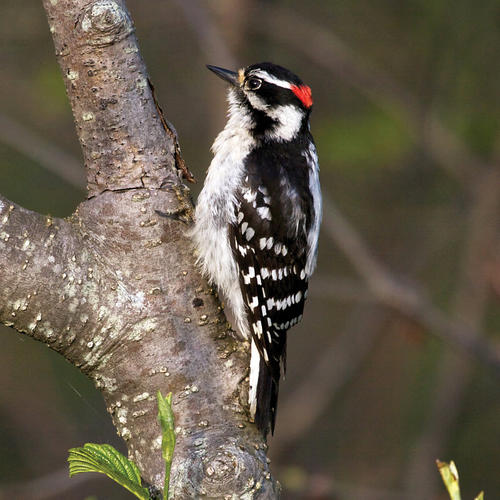Equally at home in either an urban or rural setting, the diminutive Downy woodpecker is a welcomed guest at bird feeders, especially during this rather dull time of the year.
The smallest of the Woodpecker family found in North America, the Downy is about six inches long, from the tip of its bill to the tip of the centre tail feathers. It is adorned with black and white body feathers; the males have a red patch on the back of their head. They are often confused with the larger Hairy woodpecker as both sexes of each species are similar. In addition to being considerably larger, the Hairy’s bill is about the same length as its head while the Downy’s bill is much shorter than its head. Another distinguishing feature is the outer tail feathers; the Downy has black bars on white feathers, while the Hairy’s outer tail feathers are pure white.
Male Downy’s tend to forage on small branches of trees and stalks of seed bearing plants, while the females prefer to locate their food on larger limbs and trunks of trees. (This can be an interesting way to determine the sex of the birds from a distance!). Often very acrobatic when feeding, including hanging upside down, both sexes eat insects, ants, caterpillars, seeds, berries and suet. During the winter months, Downy’s team up with assorted flocks of chickadees, nuthatches, finches and other species in search of food.
Their bodies are well adapted to their lifestyle. Clinging to a tree is aided by stiff centre tail feathers which brace and support them. Their feet differ from most other songbirds as they have two toes pointing forward and two back, enabling them to easily negotiate up and down the tree as they search for food hidden under bark. Their white breast is thought to reflect light into the dark crevices. A chisel- shaped bill is crucial in the hunting process, and their long, barbed and sticky tongue enables them to extract their quarry. The nostrils are protected from flying wood chips and dust by feathers.
Males and females live quite separate lives, usually feeding in different locations and living separately in their own tree cavity, but come late winter it is a different story. At that time both males and females will communicate their availability by drumming on tree limbs, house siding, metal downpipes or anything that will make a loud noise. The speed of the drumming is much faster than the sound made when pecking for food! At just the right time, the male will gradually approach a female and a bond is established. Males are very territorial and drive off interlopers by pursuing them from tree to tree until their patch is once again secured.
Both sexes engage in the building of the nest, which is excavated from a dead or rotting tree stub or branch. A south or east entrance exposure is preferred to capture warmth from the sun. To keep predators out, the hole will be just as large as necessary for the adults to pass through. Nests are lined with wood chips from the excavation process. Females lay and then incubate the 4-5 white eggs for 14 days. The young will fledge at three weeks of age. Juveniles will forage with their parents for a few weeks before setting off on their own.
In 2008, the Royal Canadian Mint produced a 25 cent coin with a colour image of a Downy Woodpecker encapsulated in its core. Check your pockets and piggybanks, they are worth quite a bit of money today!
Whether you find a coin or not, you can enjoy Downy Woodpeckers all winter long, just get those feeders out!
Article by David A. Homer

